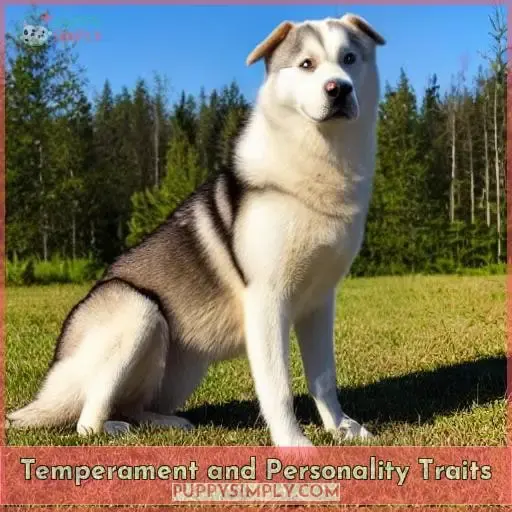This site is supported by our readers. We may earn a commission, at no cost to you, if you purchase through links.
 Picture this: a husky labrador mix. You’ve seen them in photos and videos, and you’ve fallen in love with their striking appearance and playful personalities.
Picture this: a husky labrador mix. You’ve seen them in photos and videos, and you’ve fallen in love with their striking appearance and playful personalities.
But what’s it like to own one of these dogs? Are they good with kids? Do they need a lot of exercise?
This guide will answer all your questions about husky labrador mixes, from their origins and history to their care and health needs.
Table Of Contents
Key Takeaways
- Husky lab mixes have a wide range of potential coat colors and markings due to their blended ancestry of Siberian huskies and Labrador retrievers.
- These energetic, intelligent dogs need plenty of daily exercise and mental stimulation to prevent unwanted behaviors. Long walks, interactive games, obedience training, and playtime with other dogs are important.
- Proper grooming, including weekly brushing, is essential to manage their heavy seasonal shedding.
- Husky lab mixes tend to be friendly but more independent than Labrador retrievers.
Origins and History
You’re probably wondering where this popular mixed breed originally came from when breeders first started crossing Labrador Retrievers and Siberian Huskies.
The Siberian Husky contributed its ancestry of resilience, strength, and endurance from pulling sleds in frigid climates, while the Labrador Retriever brought its eager-to-please personality and family-friendly temperament.
Crossbreeding these two purebreds evolved over recent decades to produce a loyal, energetic hybrid with an appealing blend of behavioral traits complementary to an active family lifestyle.
Though a relatively new crossbreed lacking an extensive lineage, the Husky Lab mix has an intriguing ancestral background that hybridized some of the most desirable qualities of both original breed heritages into one adventure-loving package.
Appearance and Coat Colors
Husky Lab mixes exhibit a wide range of colors and coat types that blend the features of their Siberian Husky and Labrador Retriever lineage.
Common color combinations include black, white, gray, brown, yellow, red, and sable.
Unique facial and leg markings are common.
Seasonal shedding can be significant.
The wide variety of possible coat colors, textures, and markings make each Husky Lab mix truly one-of-a-kind.
Their grooming needs vary depending on which parent they take after.
Shorter Lab-like coats require less brushing while longer Husky coats need weekly brushing, especially during seasonal sheds.
Pay attention to their unique coat qualities to keep them looking and feeling their best.
Proper grooming promotes skin and coat health.
Temperament and Personality Traits
When it comes to temperament, you’re looking at a mix of the playful, friendly Lab and the energetic, independent Husky.
| Trait | Labrador | Siberian Husky |
|---|---|---|
| Social Tendencies | Very friendly and sociable | Friendly but more independent |
| Energy Levels | Moderate energy | Very high energy |
| Behavioral Challenges | Can be mouthy as a puppy | Tendency to get bored and destructive if not stimulated |
| Intelligence Levels | Eager to please and highly trainable | Smart but stubborn and independent thinker |
| Adaptability Factors | Excellent adaptability | Does better in cooler climates |
As you can see from the table, the Husky Lab mix blends the affable Lab temperament with the spiritedness of the Siberian Husky. This is an intelligent and energetic dog that needs plenty of exercise and mental stimulation.
While friendly, they tend to be less Velcro dogs than the Lab parent. Providing proper outlets for their energy is key to preventing unwanted behaviors. With an owner committed to an active lifestyle, this mix makes a delightful, adventurous companion.
Exercise and Training Needs
Coming off those noteworthy personality traits, you’d be smart to know that Husky Lab mixes need plenty of daily exercise and mental stimulation to stay happy and healthy.
Here are some key ways to meet their needs:
- Take them on long walks and hikes to satisfy their adventurous spirit.
- Use interactive toys and games to challenge their intelligence.
- Enroll them in obedience training to reinforce good behaviors.
- Make playtime activities with other dogs a regular part of their routine to develop their social skills.
As you can see, Huskador mixes are high energy and will require an outlet for that energy on a daily basis, whether it’s physically intense activities outdoors or mental stimulation through training and games.
Meeting these needs will lead to a healthier, better-behaved dog.
Health and Care
As your energetic Husky Lab mix reaches adulthood, focus shifts toward maintaining their health.
Provide a nutritious diet tailored to their age and activity level, including quality proteins for muscle growth and whole grains for sustained energy.
Groom them weekly, using a slicker brush to distribute skin oils and remove loose hair.
Schedule annual vet exams to catch potential issues early, and update their shots on time.
Adhere to heartworm and flea/tick prevention regimens recommended for your climate.
Alongside ample outdoor playtime, engage their minds with chew toys and training games.
Mentally and physically stimulating this bright hybrid breed prevents boredom and destructive behaviors.
With proper care, your loyal companion will continue lighting up your days for years to come.
Frequently Asked Questions (FAQs)
What is the average lifespan of a husky lab mix?
The typical husky lab mix has a life expectancy of 10 to 15 years.
As hybrid vigor often leads to increased health, these even-tempered dogs tend to live happy, active lives when properly cared for.
Providing ample exercise and a quality diet supports their longevity.
With their friendly nature and moderate needs, husky lab mixes make loyal companions.
How much does a husky lab puppy cost?
A husky lab puppy typically costs $500-
As a treasured new family member, their price reflects the breeder’s care and dedication.
Still, some see monetary value first in these trusting pups.
Let’s move forward with open paws and hearts, finding connection, not transaction.
Are husky lab mixes good with children and other pets?
Yes, husky lab mixes tend to be quite good with children and other pets when properly socialized from a young age.
Their playful and outgoing nature allows them to get along well with kids.
However, small pets should be supervised, as their high prey drive may kick in.
Consistent training is key to ensuring good behavior.
How often should you brush or bathe a husky crossed with a labrador?
You should brush a husky-lab mix at least twice a week.
This will remove loose hair and prevent matting.
Bathe them every 6-8 weeks or as needed with a gentle dog shampoo.
Frequent brushing and occasional baths will keep their coat clean, minimize shedding around the home, and prevent skin irritation.
What kind of food is best for a siberian husky labrador mix?
When choosing food for a Husky-Lab mix:
- Look for a high-quality dry kibble formulated for active breeds.
- A grain-free or limited ingredient diet may be easiest on their sensitive stomachs.
Provide variety by mixing in:
- Some wet food
- Raw meat
- Eggs
- Vegetables
Monitor their weight, adjust portions as needed, and avoid overfeeding treats.
Conclusion
Having taken this comprehensive tour through the origins, traits, needs, and health of husky labrador mixes, their striking blend of sled dog stamina and family friendliness likely seems clearer.
For those seeking husky labrador mixes, your research prepares you to provide the exercise, training, socialization, and healthcare these active hybrids require.
Ultimately, their perfect pet potential depends on your commitment as their owner.











